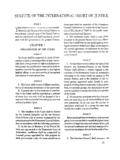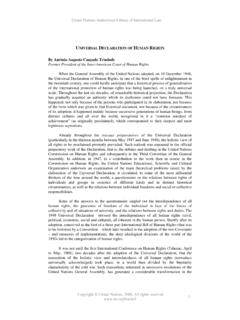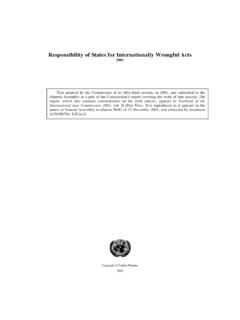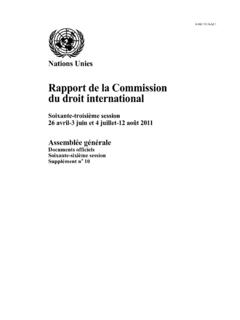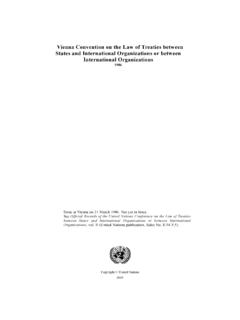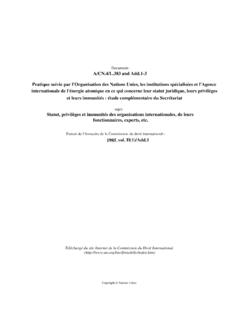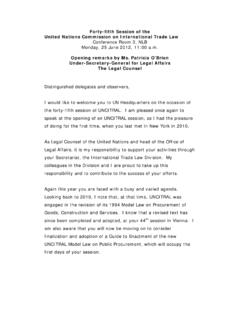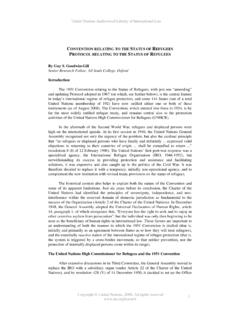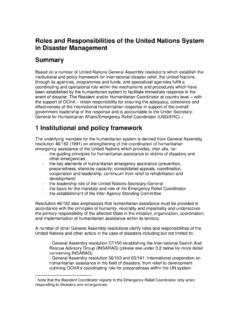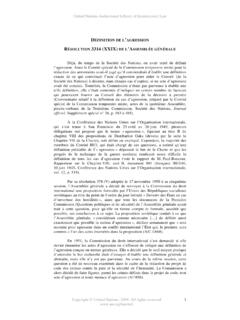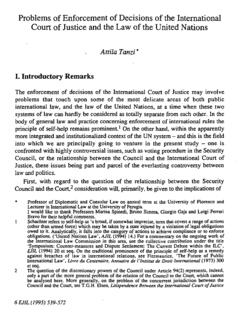Transcription of Statute of the International Court of Justice - …
1 United Nations Audiovisual Library of International Law 1 Statute OF THE International Court OF Justice By Ant nio Augusto Can ado Trindade Judge of the International Court of Justice Former President of the Inter-American Court of Human Rights Emeritus Professor of International Law of the University of Bras lia, Brazil I. Historical Antecedents and Lessons from the Past The Statute of the International Court of Justice (ICJ) counted on historical antecedents to be kept in mind, in particular in respect of the Statute of its predecessor, the Permanent Court of International Justice (PCIJ).
2 The PCIJ was created under the auspices of the League of Nations pursuant to Article 14 of the Covenant of the League of The Council of the League of Nations had been entrusted with the project for the establishment of the PCIJ. In early 1920, an Advisory Committee of Jurists was appointed, to prepare and submit a report concerning the establishment of the PCIJ. In June-July 1920, a draft scheme was prepared by the Advisory Committee, and then submitted to the Council of the League of Nations, which, upon its examination, laid it before the first Assembly of the League of Nations.
3 The Third Committee of the first Assembly, after studying the matter, submitted, in December 1920, a revised draft to the League s Assembly, which adopted it unanimously; that revised draft thus became the Statute of the PCIJ. Although the League of Nations had taken the initiative of the creation of the PCIJ, it was not integrated into the League. The PCIJ operated from 15 February 1922 (when it held its inaugural sitting) until 1940. Many treaties and conventions conferred jurisdiction upon the PCIJ. In that period, the PCIJ settled 29 contentious cases and issued 27 advisory opinions.
4 It was only in 1946 that the new ICJ was established,2 with the adoption of its Statute at the San Francisco Conference on 26 June 1945. The ICJ Statute relied upon the Statute of its predecessor, the PCIJ; even so, a process of redrafting was undertaken with the necessary adjustments in the light of the historical experience3 first by the United Nations Committee of Jurists, and then by the Fourth Committee of the United Nations Conference on International Organization (UNCIO) in San Francisco in 1945.
5 An important innovation introduced by the ICJ Statute was its structural interrelationship with the United Nations Charter. The ICJ was incorporated into the United Nations, its Statute forming an integral part of the United Nations Charter. Distinctly, in the case of the PCIJ, the relationship between the Court and the then existing procedures of other (arbitral) organs of dispute-settlement was stated in Article 1 of the PCIJ Statute , in the following terms: the PCIJ would be in addition to the Court of Arbitration organized by the Conventions of The Hague of 1899 and 1907, and to the special Tribunals of Arbitration to which States are always at liberty to submit their 1 Article 14 provided that: The Council shall formulate and submit to the Members of the League for adoption plans for the establishment of a Permanent Court of International Justice .
6 The Court shall be competent to hear and determine any dispute of an International character which the parties thereto submit to it. The Court may also give an advisory opinion upon any dispute or question referred to it by the Council or by the Assembly . 2 As the archives of the PCIJ were preserved during World War II, and as the intention at the time of the creation of the ICJ was for continuity between the PCIJ and the ICJ, the latter could take over the archives of its predecessor. 3 Besides terminological changes ( , to alter the references from the League of Nations to the United Nations).
7 United Nations Audiovisual Library of International Law 2 disputes for settlement . By contrast, the ICJ Statute is annexed to the United Nations Charter itself. It sets forth the structure of the Court , its powers and competences, and the applicable law; the ICJ s interrelationship with the United Nations is enhanced, pursuant to Article 92 of the Charter, which states that: The International Court of Justice shall be the principal judicial organ of the United Nations. It shall function in accordance with the annexed Statute , which is based upon the Statute of the Permanent Court of International Justice and forms an integral part of the present Charter.
8 Thus, while Article 92 of the ICJ Statute makes reference to the PCIJ Statute , the intimate relationship between the ICJ and the United Nations is clearly defined under Article 92 of the Charter, characterizing the ICJ as the principal judicial organ of the United Nations . This tight connection is also evidenced by Article 93 of the Charter, which states that all Member States of the United Nations are ipso facto parties to the Statute of the ICJ. Another provision which has a direct bearing on the interrelationship between the ICJ and the United Nations is Article 94 of the Charter, which provides that each Member State of the United Nations undertakes to comply with the decision of the International Court of Justice in any case to which it is a party.
9 These provisions show that, although the ICJ Statute relied on the PCIJ Statute , it also included innovations, in particular as to the interrelationship between the World Court and the United Nations. With the establishment of the ICJ, much was learned from the experience of the PCIJ, and also from its jurisprudence (infra). In April 1946, with the formal dissolution of the PCIJ, the ICJ came into operation. II. Basis of International Jurisdiction The ICJ Statute secures (Article 9), in the composition of the Court , the due representation of the main juridical systems of the world.
10 The ICJ is composed of 15 judges, elected by the United Nations General Assembly and Security Council. There cannot be two judges of the nationality of the same State. In case there is not, amongst the members (elected judges) of the ICJ, a judge of the nationality of a State as contending party, this State can designate a judge ad hoc, of its choice, for the concrete case, once his or her name is approved by the members of the ICJ. The ICJ, throughout its history, has defined its role in the judicial settlement of International disputes, as the judicial organ of the legal order of the International community as a whole, and not only of the contending parties appearing before In recent years, the ICJ has been called to pronounce upon the most diverse areas of International law, in cases originating from all the regions of the world.
